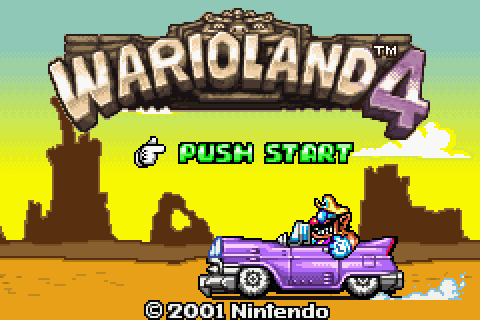
Wario Land 4 is 1 o’ those games I’ll admit I love mo’ for its atmosphere than its gameplay, though its gameplay is certainly great—albeit, the game is rather short @ only 18 levels. It had a dark, urban strangeness that reminds me o’ a less heartfelt Earthbound. I think the fact that I 1st witnesses it @ round 4 AM influenced my association, for I don’t think any game captures that feeling I may have only made up myself o’ a groggy early waking in the late after-midnight1.
In fact, I consider its soundtrack full o’ samples o’ strange voices shouting, “¡HURRY UP!” traffic noises, cat meows, & childish laughs to be more o’ a spiritual successor o’ Earthbound‘s than Mother 3′s, & to be probably the best o’ all the GBA soundtracks. Like Earthbound‘s music, these songs seem to be full o’ so many strange details that it’s impossible to keep track o’ them all, lending it a mysterious feel.
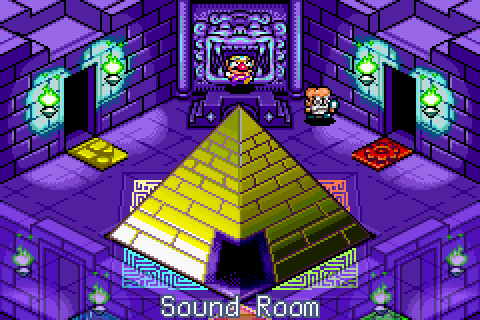
The map theme demonstrates this the most. It’s such a long & complicated song for a song that’ll only play ‘tween choosing levels. A mash o’ low grungy music & rather high-pitched spacey sounds, this song isn’t e’en consistent on whether it wants to have a catchy melody or being a jarring cacophony o’ strange noises that makes it e’en mo’ disjointed than consistent cacophony.
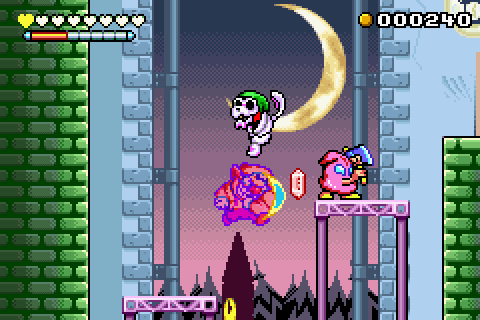
“Crescent Moon Village” I love for being the best representation o’ urban nights, mixing the high-pitched weal o’ nighttime wind with the heavy bass rock you’d faintly hear from a passing car.
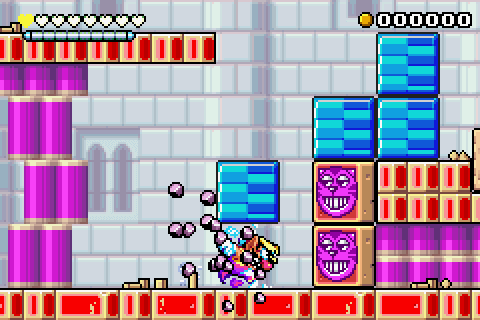
“Toy Block Tower”: Much like Earthbound, Wario Land 4 balanced its soundtrack’s dark songs with very chipper songs, & this is the most chipper ‘mong Wario Land 4‘s, fitting the most chipper o’ levels. This level & its music are like walking out o’ the hushed night into a brightly-lit 24-hour store that ne’er seemed to tire.
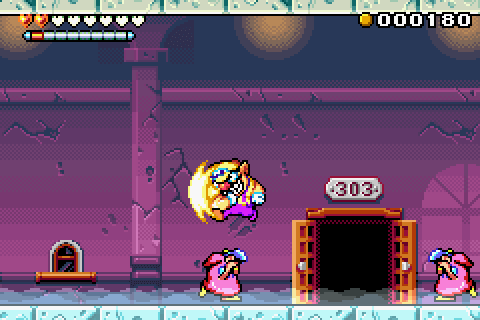
“Hotel Horror” is a jazzy song on the surface; but like most WL4 songs, it has those strange sound effects that make it eerier—in this case, mainly the noises from what can only be described as a windy drum, starting as an elongated blow that sounds somewhat like an airplane passing by, & then becoming chopped up into mo’ forceful beats.
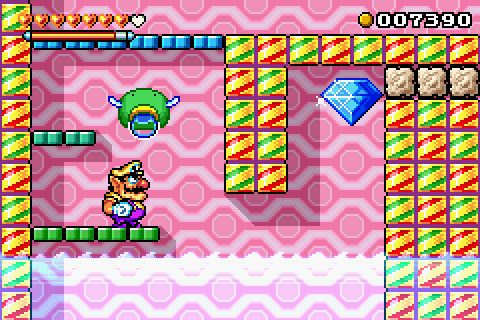
“Soft Shell” is soothing mall music that plays in soothing bonus areas. I change what I said ’bout “Toy Block Tower”: this is the brightly-lit 24-hour shop.
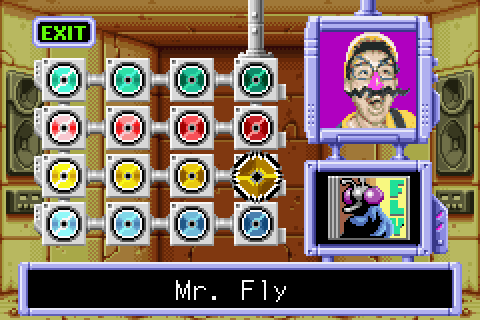
But we can’t talk ’bout Wario Land 4‘s soundtrack without mentioning the “sound test,” unlocked song-by-song by collecting CDs from each level. Those who have read much o’ this blog (I’m sorry) would probably guess that I’d love such a disarray o’ irrelevant sound experiments—visualized through a neon-backdropped screen flashing ‘tween random images, such as the Game & Watch guy with headphones, a photorealistic strawberry zooming in & out, & some real human cosplaying as Wario. Some o’ them are actually songs, such as the aforementioned “Soft Shell,” & “Mr. Ether & Planetaria”; but most are just collections o’ noises, such as 1 which is just a buzzing fly that is finally smitten, a sleeping guy snoring, heavy mechanical heartbeats, hushed whispers, &, my favorite, an epic o’ some guy waking up to go out & walk to the store to buy something, & then walking back home, all depicted through speechless noises.
The graphics were similarly strange, though mo’ in a cartoony grotesque way than in a “¿What the hell is this?” way. Zombie Wario wasn’t just a stereotypical dark blue version o’ himself with tattered clothes & dark eyes, but was made up o’ neon rainbow goop that splashed all o’er. Puffy Wario had mo’ exaggerated cheeks than in the previous entries. The animation was also quite smooth.
How level progress was measured was also rather creative: rather than a simple goal @ the end, one’s goal was to collect various objects, hit a switch, & then race back to the start before time (& then one’s coins) ran out. The key ghost named Keyzer was needed to unlock the next level & all 4 corners o’ the gem is needed for all 4 levels per zone were needed to unlock that zone’s boss. It’s interesting ’cause most games have levels wherein “beating” it is plain, black & white; but here it’s messier. Obviously we can’t say that just hitting the switch & returning to the beginning warp “beats” the level, ’cause it creates no progress: you’re right back where you started. ¿But is getting the Keyzer sufficient? It is for the 1st few levels; but if one wants to fight the boss—& therefore progress to the end o’ the game—one must collect all o’ the gem corners. Since it’s required to beat the game—rather than the CD, which is just useful for hearing the aforementioned weird-ass music in the “sound test,” or any money—one could argue that the level’s not truly beaten—as opposed to completed, which would require the CD & collecting 10,000 coins for the golden crown—’less the gems are collected, too.
Wario Land 4 also lets one try all o’ the zones but the last in any order one wants, including going back & forth ‘mong zones. This is hardly the 1st game to do something like this; but it’s still a plus, nonetheless.
That said, though its music, graphics, & general atmosphere are better than its predecessors, it’s gameplay is inferior to Wario Land 3‘s. It’s much shorter & its levels are much less complex than 3’s, which had a much funner goal system derived from 4 different colored pairs o’ keys & chests per level, which unlock items that unlock other chests & so on.
Footnotes:
[1] WarioWare, inc.: Mega Microgame$!, which I shall discuss soon & I 1st discovered @ a similar time o’ day & in Japanese, as well as having a similar soundtrack (some songs & sound effects are flat-out taken from this game, & the whole soundtrack’s done by the same guy), comes to a close 2nd.


